Corporate museums are part academic and business and occupy the grey zone in between. It is an organization that works with several departments in a company including public relations, branding, advertising, and HR. This series aims to look at the role, function, and future of museums run by corporations through interviews with PR professionals.
The Industrial Heritage at Kurobe River that Kansai Electric Wants to Pass on to Future Generations
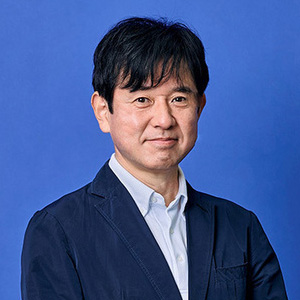
Koki Aihara, PR Consulting Dentsu
The power generation facilities on the Kurobe River system in Toyama Prefecture are an industrial heritage site selected by the International Council on Monument and Sites (ICOMOS) as one of Japan’s select 20 20th Century Heritage Sites. It is ranked fourth in terms of importance, following “Ueno Onshi Park and Cultural Facilities,” “Yoyogi National Indoor Stadium,” and “Tateyama Erosion Control Facilities.” The Kurobe River Electric Memorial Museum, operated by the Kansai Electric Power Company (KEPCO), conveys its historical and academic values. This article explores how KEPCO, which has supported the development of the Kinki economy with electric power, is working to pass on to future generations the history and significance of its power generation facilities as they attract attention as an industrial heritage of humankind.
Introduction
Kurobe Hydropower Museum is operated by Kansai Electric Power (KEPCO). Visitors can change trains to the Toyama local railway at Kurobe Unazuki Onsen Station on the Hokuriku Shinkansen Line and be surrounded by the Northern Alps mountains in about 20 minutes. After a gradual ascent along the Kurobe River, the train arrives at its terminus at Unazuki Onsen. About a minute’s walk from there is a three-story mountain lodge-like structure in front of Unazuki Station, the starting point of the Kurobe Gorge Railway trolley. The museum is located on the first floor of the building.
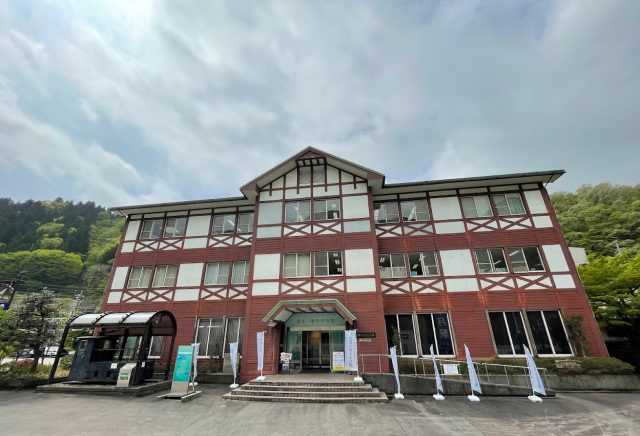
Kurobe Hydropower Museum takes up the entire first floor of the building (Photo by the writer)
Kurobe Hydropower Museum, located in Kurobe City, Toyama, is a free public relations facility that opened in 1987 to introduce the history of power supply development along the Kurobe River, nature around the Kurobe Gorge, and hydroelectric power plants. After full renovations in April 1996 and March 2012, it reopened on March 31, 2023, after partially revamping the exhibit area beginning in December 2022.
Kansai Electric Power Company’s Public Relations Office in Osaka oversees the facility, while its Hokuriku Branch Office in Toyama handles day-to-day operations. The Hokuriku Branch Office is responsible for event planning and media relations. It deals with various initiatives in collaboration with the local community, including the Kurobe Gorge Railway and Unazuki Hot Springs. Several local staff members oversee the 427 square meter exhibition room on the first floor, with a total floor space of 1,519 square meters, with a display of 14 items.
In addition to this museum, Kansai Electric has three public relations facilities near its nuclear power plant operations in Fukui Prefecture and one near its thermal power plant in Maizuru City, Kyoto Prefecture.
A Japanese Power Supplier
Until the full liberalization of the electricity retail market in 2016, Japanese power suppliers were divided into general power suppliers, wholesale electricity operators, wholesale power suppliers, specific-scale electricity operators, and specified electric utility businesses.
General power suppliers provide a full range of services to the general public, from power generation to the transmission and distribution of electricity. Japan has ten major power companies, and as one of them, KEPCO has been supplying electric power to Osaka, where its head office is located, Kyoto, Hyogo (excluding some areas), Nara, Shiga, and Wakayama, as well as parts of Mie, Gifu, and Fukui prefectures.
We had Yoshihiro Matsumoto and Yutaka Yoshizaki of the Communication Management Group, Hokuriku Branch Office of Kansai Electric Power Co., join us at the museum to tell us about the facilities.
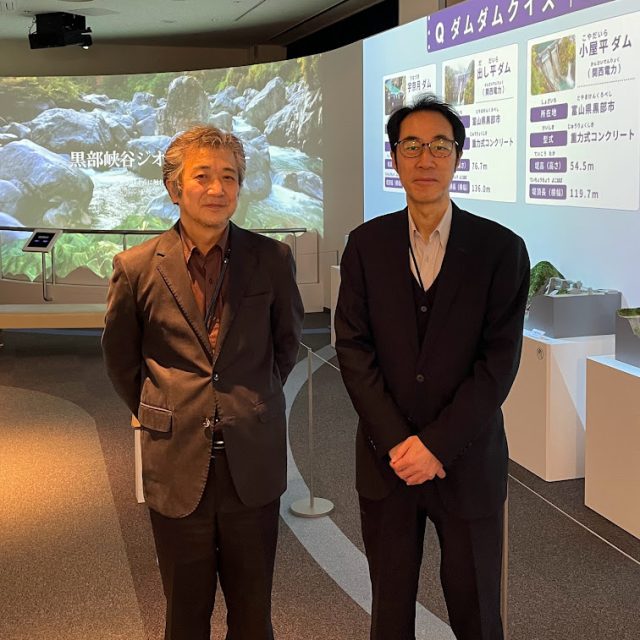
(L-R:) Yutaka Yoshizaki and Yoshihiro Matsumoto, responsible for public relations activities related to Kansai Electric’s hydroelectric power plant in the Hokuriku area (Photo by the writer)
The Hokuriku Branch Office is responsible for all public relations activities related to Kansai Electric’s hydroelectric power generation facilities in the Hokuriku area. The company owns 38 hydroelectric power plants in four water systems: the Kurobe River, the Jintsu and Shogawa Rivers that run through Toyama Prefecture, and the Kuzuryu River in Fukui Prefecture, generating a total licensed maximum output of approximately 1.92 million kilowatts (roughly 60 percent of the company’s general hydroelectric generation) and about seven billion kWh per year. As interest in renewable energy has been growing in recent years, hydroelectric power, which can generate power quickly, is in an important position as a purely domestic energy source.
Kurobe River, with 12 power plants
Why isn’t the Kurobe Hydropower Museum located near Kurobe Dam, famous for its Kuroyon (Kurobe Dam and the Kurobegawa No. 4 Power Plant)? That was the simple question that crossed this writer’s mind at first. Embarrassingly enough, I initially thought that Kurobe Dam was a power plant. It’s necessary to recognize that power development has been promoted at Kurobe Dam and in the entire Kurobe River system for a long time, and such facilities are scattered throughout the area.
Unazuki is the starting point for this power supply development. KEPCO owns four dams and 12 hydroelectric power plants on the Kurobe River. These facilities are unmanned and controlled remotely from the Integrated Hydroelectric Control Center in Osaka, and the generated electricity is sent mainly to the Kansai region. Among them, the largest facility, Kurobegawa No. 4 Power Station, is situated 10 kilometers downstream from the dam, and all its facilities, including the power station, are underground.
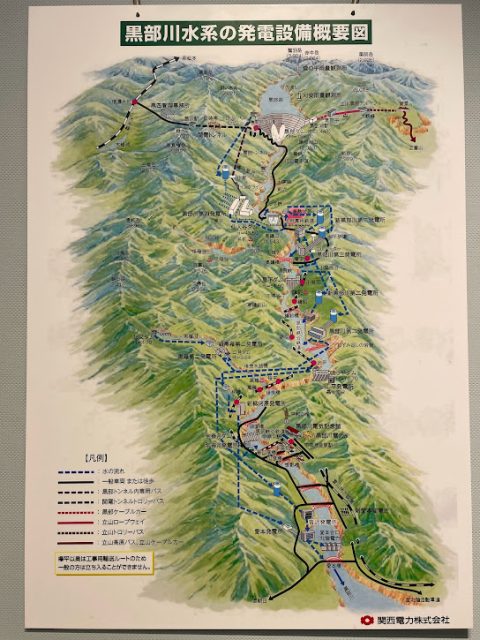
An overview of power generation facilities in the Kurobe River system, displayed at the museum (Photo taken by the writer)
The museum’s renewal is not only a measure against aging, as about a decade has passed since the last revamping. A part of the exhibition area has been renovated so visitors can enjoy learning about zero carbon. This year marks the 60th anniversary of the completion of Kuroyon, and the Kurobe Route, which had been used for construction, will open to the public and become a tourist product when the Kurobe-Unazuki Canyon Route opens to traffic. In addition, this year, 2023, marks the 100th anniversary of the opening of Unazuki hot springs. Kansai Electric hopes that by having many people visit on its renovation and giving them a taste of its appeals, it can help promote local tourism.
The mechanism of hydroelectric power seen in dioramas and videos
The Kurobe Hydropower Museum consists of two zones: the Waku-waku exploration zone, where anyone can learn by seeing, touching, and experiencing, and the somewhat specialized Ever-increasing knowledge zone that serves as a type of library. For foreign visitors, English, Chinese, and Korean are also available. Although the target audience is primarily tourists, the museum is operated for a variety of stakeholders, including academia, employees of KEPCO Group companies, and local elementary and junior high schools, as it is not only a tourist resource but also has academic value and significance in conveying the history of Japan’s industrial heritage.
There are three new types of exhibits in the Waku-waku exploration zone. The Briefing Station uses a large screen to convey the content of the museum’s exhibits. The Dam Dam Quiz Theater provides visitors with information about hydroelectric power in a quiz format, and the Kurobe Gorge Diorama Theater introduces the seasonal nature of the gorge, the history of power supply development, and the mechanism of hydroelectric power through dioramas and powerful images.
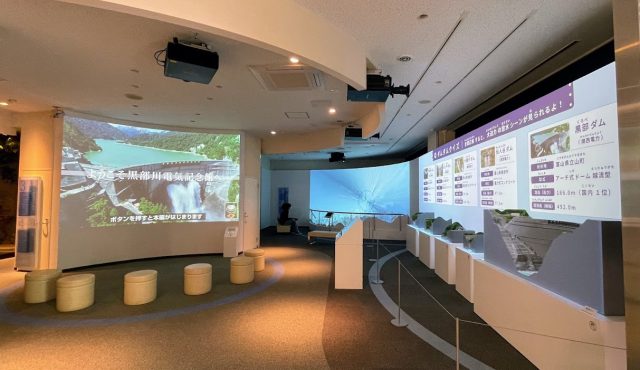
The Briefing Station is seen on left; Kurobe Gorge Diorama Theater (far back); Dam Dam Quiz Theater (R) (Photo taken by the writer)
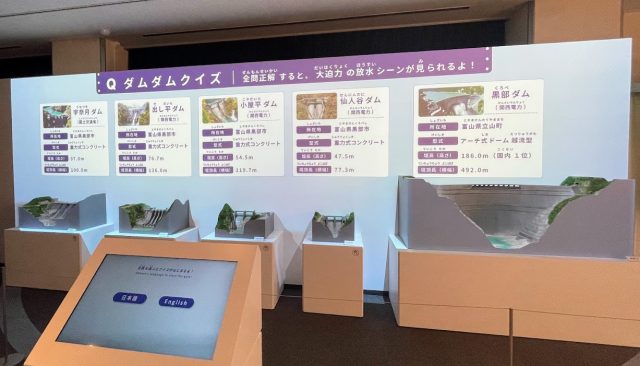
When all the quiz questions are answered correctly, a 1/300 scale model of the five dams on the Kurobe River releases water at once. Kansai Electric owns four; one is by the Ministry of Land, Infrastructure, Transport and Tourism. (Photo taken by the writer)
In the popular “Take a journey on a trolley train”, visitors can take a seat and enjoy impressive panoramic visuals created by a multi-image display spreading out before their eyes, giving them an impression of riding on a train regardless of the weather or season. The Kurobe River Power Development section showcases valuable photos and videos of Kurobe River’s power development process; visitors can enjoy seeing a striking video and hearing about Kuroyon (Kurobe Dam and Kurobegawa No. 4 Power Station) as a great construction project of the century.
In particular, an exhibit of the Omachi Tunnel (now the Kanden Tunnel) construction, said to have been a most difficult project, allows visitors to learn about the manual excavation work at the time at the push of a button that plays the video clip.
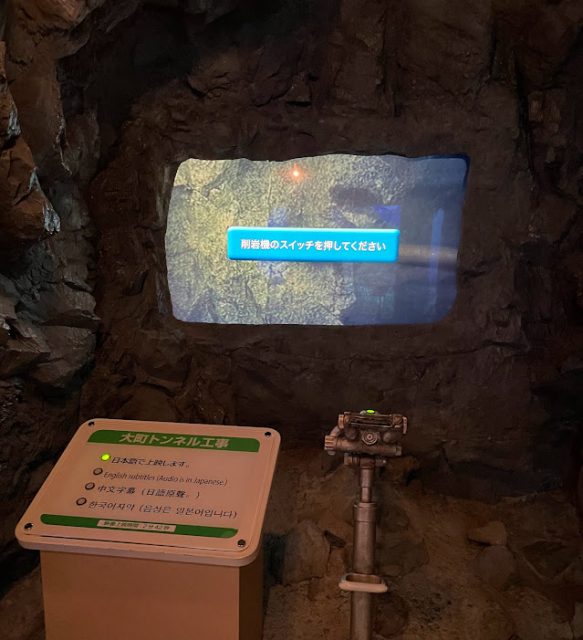
Exhibition explaining the creation of the Omachi Tunnel, the most difficult construction project
Many museum visitors have come across the facility while touring Unazuki Onsen and Kurobe Gorge. Some 600,000 to 700,000 visitors use the trolley car annually, and the Kurobe-Unazuki Canyon Route, due to open next year, will surely bring in more tourists.
Valuing coexistence with the local community, the Kurobe River Electric Memorial Museum hopes to attract visitors of all ages by leveraging its convenient location at the Kurobe Gorge entrance. Ichiro Kume, General Manager of Kansai Electric’s Hokuriku Branch then, said, “We hope more people will visit the museum and deepen their understanding of energy and that it will help promote tourism in the region.” A banner has recently been set up at the front of the building to attract the attention of tourists.
An area has also been set up to sell souvenir goods
Next to the information desk is an area selling items related to the trolley train and Kurobe Gorge. The most popular item is Choro Q, a miniature version Kurobe Gorge trolley car, and towels and stationery are also available for purchase.
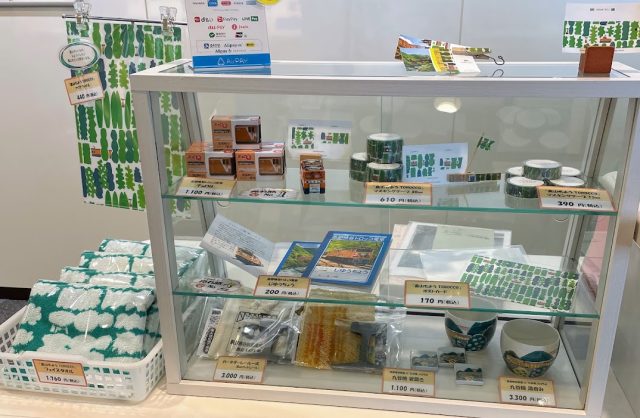
Kurobe Gorge Railway shop (Photo taken by the writer)
Here is a brief description of the natural environment around Kurobe Gorge, the history of power supply development, and major facilities such as the Kurobe Dam.
History of Kurobe River Power Supply Development
Hydroelectric power development in the Kurobe River basin began in the Taisho Era (1912-1926). The Kurobe Gorge, located between 3,000-meter-high mountains known as the roof of Japan, is an inhospitable terrain. It is also one of the country’s most rainy and snowy regions and has a steep river, making it extremely favorable for hydroelectric power.
In 1917, Dr. Jokichi Takamine, the discoverer of taka-diastase, was the first to note the possibility and begin studies on hydroelectric power generation in Kurobe. In 1923, excavation began on a track opening between Unazuki and Nekomata, and excavation work and research also started for the Nichiden walkway.
Yanagigawara Power Station, the first power plant in the Kurobe Gorge, began operations in 1927, three years after the commencement of construction using trolley cars to transport construction materials. The line was opened as far as Keyakidaira in 1937. A ticket from the time says, “We will not guarantee safety,” showing the dangers of trains running along the precipitous cliffs. In 1936, the Aimoto Power Station downstream of Unazuki began operation, followed by the Kurobegawa No.2 and No.3 Power Stations constructed up the Kurobe River.
Construction of Kuroyon, called “Major construction project of the century,” began in July 1956. The postwar economic recovery was in full swing at the time, and the Kansai region had been facing a serious shortage of electric power. Hydroelectric power was still the mainstream rather than thermal power. Kansai Electric had just been established due to the reorganization of the electric power industry. It took on the challenging construction project with the company’s fate at stake. Despite the tough conditions posed by nature, construction work was carried out using the latest technology available and was completed in June 1963 after seven years. The project cost came to 51.3 billion yen (at the time) and involved 10 million workers. As a result, the electric power situation in Kansai improved greatly. More specific facts are as follows:
Kurobe Dam: The highest dam in Japan at 186 meters, with a crest length of 492 meters and a total storage capacity of approximately 200 million cubic meters, Kurobe Dam is a rainbow of water releases that take place from the end of June to mid-October, adding color to its beauty.
Kurobegawa No. 4 Power Plant: Located about 10 kilometers downstream from Kurobe Dam. The power station and switchyard were installed underground to preserve the national park’s landscape and avoid snow damage in winter. The dam is a dam and conduit type with a drop of 545.5 meters and a maximum output of 337,000 kilowatts.
Omachi Tunnel (now called Kanden Tunnel): Managed by Kansai Electric Power Company. A 5.4-kilometer-long road tunnel connects Omachi City, Nagano Prefecture, and Tateyama Town, Toyama Prefecture. The tunnel encountered a fracture during construction that temporarily halted excavation, making the Kuroyon construction project particularly difficult.
Kurobe Gorge Trolley Trains
The trolley train runs leisurely from Unazuki Station, where the Kurobe Hydropower Museum is located, to Keyakidaira Station, about 20 kilometers along the Kurobe River, taking about 80 minutes each way through the deepest V-shaped gorge in Japan with an elevation difference of 375 meters. Nihon Denryoku built it from the Taisho Era to the early Showa Era. It was taken over by Kansai Electric in 1951 and is now operated by Kurobe Gorge Railway, a group company of Kansai Electric.
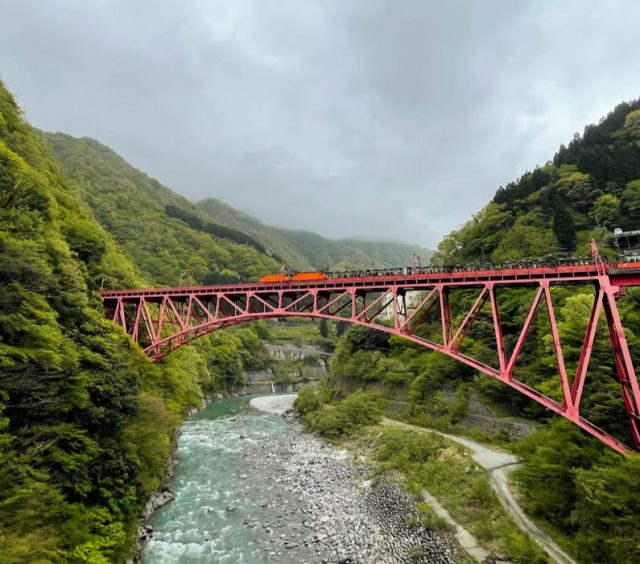
Kurobe Gorge, where the trolley train runs (Photo taken by the writer)
Collaboration with local authorities
The Kurobe-Unazuki Canyon Route, a new 18-kilometer route from Keyakidaira in Kurobe Gorge, the deepest V-shaped gorge in Japan, to the Kurobe Dam upstream, will open in 2024. With the development of power sources along the Kurobe River, Nihon Denryoku and Kansai Electric needed to develop the transportation route for construction.
Kansai Electric is implementing safety measures based on “Agreement on the opening of the Kurobe Route to the Public and the Commercialization of Travel Products” it signed with Toyama Prefecture in 2018. It is a rare spot where visitors can experience the magnificent nature of the unexplored Kurobe mountains and the history of power supply development that has brought together the wisdom of humankind. An extraordinary ride that has been in operation since the early Showa Period (1926-1989) awaits visitors with a travel experience full of surprises, which will create a new tourist route linking the Kurobe Gorge and the Tateyama Kurobe Alpine Route, boasting world-class mountain scenery and is a popular tourist destination.
And finally…
As a leading zero-carbon energy company, the Kansai Electric Power Group aims to achieve zero CO2 emissions from its business activities by 2050 under the slogan, “Take action together toward zero carbon!” In this context, the role of hydroelectric power, which requires no fossil fuels and emits no CO2, is extremely important.
For modern people, life without electricity is inconceivable. The power generation facilities on the Kurobe River system, which boasts being one of the top power generators in Japan, are still in operation despite being built more than half a century ago. While introducing new technologies to improve power generation efficiency, we must remember that inspection and maintenance work continues to be carried out by many people without time to rest in the harsh natural environment. The Kurobe River Electric Memorial Museum will continue to tell visitors who come to Kurobe Gorge about the history and current state of power supply development that has brought together the wisdom of humankind.
